
Canoeing at the 2004 Summer Olympics was held at the Schinias Olympic Rowing and Canoeing Centre for the sprint events and the Olympic Canoe/Kayak Slalom Centre at the Helliniko Olympic Complex for the canoe and kayak slalom disciplines. A total of 16 events were contested, 12 sprint events and 4 slalom events.

The Schinias Olympic Rowing and Canoeing Centre was built to host the rowing and canoe sprint events at the 2004 Summer Olympics in Greece.

Ericameria is a genus of North American shrubs in the family Asteraceae.

Schinia, commonly called flower moths, is a large genus of moths belonging to the family Noctuidae. The genus has a Holarctic distribution with the vast majority of species being found in North America, many with a very restricted range and larval food plant.

Eucalyptus obliqua, commonly known as messmate stringybark or messmate, but also known as brown top, brown top stringbark, stringybark or Tasmanian oak, is a species of tree that is endemic to south-eastern Australia. It has rough, stringy or fibrous bark on the trunk and larger branches, smooth greyish bark on the thinnest branches, lance-shaped to curved adult leaves, flower buds in groups of seven to fifteen or more, white flowers and cup-shaped or barrel-shaped fruit.

Brickellia is a North American genus of about 100 to 110 species of plants in the family Asteraceae, known commonly as brickellbushes. They are found in Canada, the United States, Mexico, and Central America. Many species are native to the American southwest, especially Texas. Brickellia is among the more basal lineages of the Eupatorieae and should not be assigned to a subtribe pending further research.

Nothofagus obliqua, commonly known as Patagonian oak, roble, pellín, roble pellín, and hualle in its early state of growth or roble beech, is a deciduous tree from Chile and Argentina. It grows from 33 to 43° south latitude. The northern extent of this tree's range in Chile is considered to be the Vizcachas Mountains and La Campana National Park. N. obliqua was proposed to be renamed Lophozonia obliqua in 2013.

Ficus obliqua, commonly known as the small-leaved fig, is a tree in the family Moraceae, native to eastern Australia, New Guinea, eastern Indonesia to Sulawesi and islands in the southwestern Pacific Ocean. Previously known for many years as Ficus eugenioides, it is a banyan of the genus Ficus, which contains around 750 species worldwide in warm climates, including the edible fig. Beginning life as a seedling, which grows on other plants (epiphyte) or on rocks (lithophyte), F. obliqua can grow to 60 m (200 ft) high and nearly as wide with a pale grey buttressed trunk, and glossy green leaves.
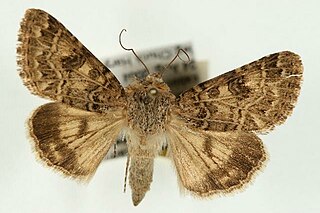
Schinia cupes is a moth of the family Noctuidae. It is found from Texas, west to New Mexico and north to Kansas and Colorado.
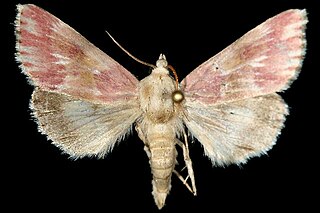
The bleeding flower moth is a moth of the family Noctuidae. It is found from North Carolina to Florida, west to Texas, north to Montana. There is also a disjunct population in Ontario.

Schinia aurantiaca is a moth of the family Noctuidae. It is found in North America, including California and Arizona.
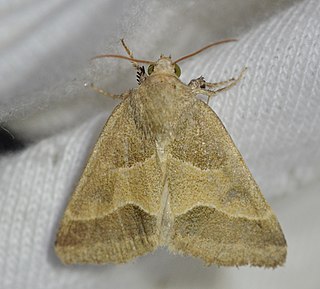
Schinia gracilenta, the slender flower moth or iva flower moth, is a moth of the family Noctuidae. The species was first described by Jacob Hübner in 1818. It is found from the US states of New York to Florida and Nebraska to Arizona. The species is listed as endangered in Connecticut.
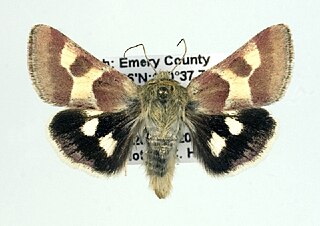
Schinia suetus is a moth of the family Noctuidae first described by Augustus Radcliffe Grote in 1873. It is widespread in the mountains of western North America, from southern Alberta west to British Columbia, south at least to Colorado and California, east to Idaho and New Mexico.

Schinia nundina, the goldenrod flower moth, is a moth of the family Noctuidae. The species was first described by Dru Drury in 1773. It is found in North America from Minnesota to southern Ontario and Nova Scotia, south to central Florida and southern Texas. Records include Arizona, Kansas, Nebraska, New York, Maryland, Oklahoma and South Carolina.

Schinia scutosa, the spotted clover, is a moth of the family Noctuidae. It is found from Europe to southern Siberia, the Near East and the Middle East and from central Asia to Japan. In North Africa it is found from Morocco to Egypt.

Schinia obscurata, the obscure schinia moth, is a moth of the family Noctuidae. It is found from Ontario and Quebec south into the United States, where it has been recorded from Illinois, New Jersey, South Carolina, Wisconsin, Kansas, Montana, Nebraska, North Dakota, Oklahoma and Texas.
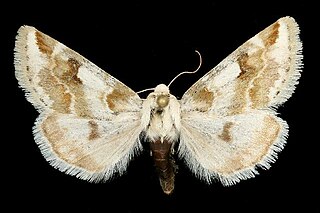
The rabbitbush flower moth is a moth of the family Noctuidae. It is found from central Arizona and New Mexico, north to Colorado, south-western Wyoming and Utah, west to Nevada and California, and north to Oregon, Idaho and Washington.

Spilosoma obliqua, the jute hairy caterpillar or Bihar hairy caterpillar, is a moth of the family Erebidae. It is found in south-eastern Afghanistan, northern Pakistan, India, Bhutan, Bangladesh and Myanmar.
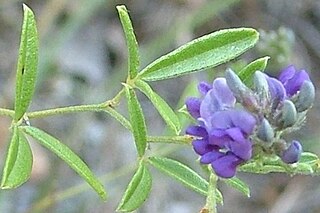
Psoralidium tenuiflorum, the slimflower scurfpea, is a perennial in the pea family. It is about 2–3 feet (0.6–0.9 m) tall and has a lot of leaves on top. Its leaves can reach a length of 3 inches (80 mm). This flower can be found mainly in the central and southwestern U.S.


















